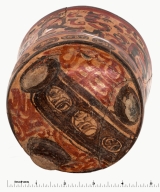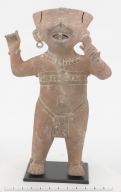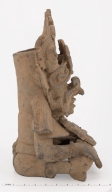|
REFINE
Browse All : Images of MAW Collection from between 600 and 800
1-40 of 40
Title
Face pendant : bibhead.
Description
Jade, jadeite and greenstones were considered a precious material with supernatural qualities associated with water, maize, fertility, and the sky. The bibhead pendant may have been an heirloom handed down from one generation to another generation.
Subject
[Pendants (Jewelry)--Guatemala, Stone carving--Guatemala, Art--Guatemala, Mayas--Antiquities]
Date
between 600 and 800
Title
Face pendant : bibhead.
Description
Jade, jadeite and greenstones were considered a precious material with supernatural qualities associated with water, maize, fertility, and the sky. The bibhead pendant may have been an heirloom handed down from one generation to another generation.
Subject
[Pendants (Jewelry)--Guatemala, Stone carving--Guatemala, Art--Guatemala, Mayas--Antiquities]
Date
between 600 and 800
Title
Face pendant : bibhead.
Description
Jade, jadeite and greenstones were considered a precious material with supernatural qualities associated with water, maize, fertility, and the sky. The bibhead pendant may have been an heirloom handed down from one generation to another generation.
Subject
[Pendants (Jewelry)--Guatemala, Stone carving--Guatemala, Art--Guatemala, Mayas--Antiquities]
Date
between 600 and 800
Title
Face pendant : bibhead.
Description
Jade, jadeite and greenstones were considered a precious material with supernatural qualities associated with water, maize, fertility, and the sky. The bibhead pendant may have been an heirloom handed down from one generation to another generation.
Subject
[Pendants (Jewelry)--Guatemala, Stone carving--Guatemala, Art--Guatemala, Mayas--Antiquities]
Date
between 600 and 800
Title
Maya flared bowl.
Description
This polychrome ceramic bowl was created with a flaring rim bowl. The bowl's cream slip background has been decorated with brown netted triangles, a red-brown step-fret band, and an orange geometric band.
Subject
[Pottery--El Salvador, Ceramic bowls--El Salvador, Maya art--El Salvador, Mayas--Antiquities, Indigenous peoples--Antiquities]
Date
between 600 and 800
Title
Maya flared bowl.
Description
This polychrome ceramic bowl was created with a flaring rim bowl. The bowl's cream slip background has been decorated with brown netted triangles, a red-brown step-fret band, and an orange geometric band.
Subject
[Pottery--El Salvador, Ceramic bowls--El Salvador, Maya art--El Salvador, Mayas--Antiquities, Indigenous peoples--Antiquities]
Date
between 600 and 800
Title
Maya flared bowl.
Description
This polychrome ceramic bowl was created with a flaring rim bowl. The bowl's cream slip background has been decorated with brown netted triangles, a red-brown step-fret band, and an orange geometric band.
Subject
[Pottery--El Salvador, Ceramic bowls--El Salvador, Maya art--El Salvador, Mayas--Antiquities, Indigenous peoples--Antiquities]
Date
between 600 and 800
Title
Maya flared bowl.
Description
This polychrome ceramic bowl was created with a flaring rim bowl. The bowl's cream slip background has been decorated with brown netted triangles, a red-brown step-fret band, and an orange geometric band.
Subject
[Pottery--El Salvador, Ceramic bowls--El Salvador, Maya art--El Salvador, Mayas--Antiquities, Indigenous peoples--Antiquities]
Date
between 600 and 800
Title
Maya flared bowl.
Description
This polychrome ceramic bowl was created with a flaring rim bowl. The bowl's cream slip background has been decorated with brown netted triangles, a red-brown step-fret band, and an orange geometric band.
Subject
[Pottery--El Salvador, Ceramic bowls--El Salvador, Maya art--El Salvador, Mayas--Antiquities, Indigenous peoples--Antiquities]
Date
between 600 and 800
Title
Maya flared bowl.
Description
This polychrome ceramic bowl was created with a flaring rim bowl. The bowl's cream slip background has been decorated with brown netted triangles, a red-brown step-fret band, and an orange geometric band.
Subject
[Pottery--El Salvador, Ceramic bowls--El Salvador, Maya art--El Salvador, Mayas--Antiquities, Indigenous peoples--Antiquities]
Date
between 600 and 800
Title
Tripodal cylinder.
Subject
[Pottery--Honduras--Ulúa River Valley, Ceramic sculpture--Honduras--Ulúa River Valley, Art--Honduras--Ulúa River Valley, Mayas--Honduras--Ulúa River Valley, Indigenous peoples--Antiquities]
Date
between 600 and 800
Title
Tripodal cylinder.
Subject
[Pottery--Honduras--Ulúa River Valley, Ceramic sculpture--Honduras--Ulúa River Valley, Art--Honduras--Ulúa River Valley, Mayas--Honduras--Ulúa River Valley, Indigenous peoples--Antiquities]
Date
between 600 and 800
Title
Tripodal cylinder.
Subject
[Pottery--Honduras--Ulúa River Valley, Ceramic sculpture--Honduras--Ulúa River Valley, Art--Honduras--Ulúa River Valley, Mayas--Honduras--Ulúa River Valley, Indigenous peoples--Antiquities]
Date
between 600 and 800
Title
Tripodal cylinder.
Subject
[Pottery--Honduras--Ulúa River Valley, Ceramic sculpture--Honduras--Ulúa River Valley, Art--Honduras--Ulúa River Valley, Mayas--Honduras--Ulúa River Valley, Indigenous peoples--Antiquities]
Date
between 600 and 800
Title
Tripodal cylinder.
Subject
[Pottery--Honduras--Ulúa River Valley, Ceramic sculpture--Honduras--Ulúa River Valley, Art--Honduras--Ulúa River Valley, Mayas--Honduras--Ulúa River Valley, Indigenous peoples--Antiquities]
Date
between 600 and 800
Title
Tripodal cylinder.
Subject
[Pottery--Honduras--Ulúa River Valley, Ceramic sculpture--Honduras--Ulúa River Valley, Art--Honduras--Ulúa River Valley, Mayas--Honduras--Ulúa River Valley, Indigenous peoples--Antiquities]
Date
between 600 and 800
Title
Standing figure representing a ballplayer.
Description
During the Mesoamerican ballgame, ballplayers wore special equipment to protect themselves from injury and to help deflect and hit the ball. A rubber ball could be hit with a force that could easily maim or kill a player.
Subject
[Ceramic sculpture--Belize, Maya sculpture--Belize, Maya art--Belize, Mayas--Antiquities, Indigenous peoples--Antiquities]
Date
between 600 and 800
Title
Standing figure representing a ballplayer.
Description
During the Mesoamerican ballgame, ballplayers wore special equipment to protect themselves from injury and to help deflect and hit the ball. A rubber ball could be hit with a force that could easily maim or kill a player.
Subject
[Ceramic sculpture--Belize, Maya sculpture--Belize, Maya art--Belize, Mayas--Antiquities, Indigenous peoples--Antiquities]
Date
between 600 and 800
Title
Standing figure representing a ballplayer.
Description
During the Mesoamerican ballgame, ballplayers wore special equipment to protect themselves from injury and to help deflect and hit the ball. A rubber ball could be hit with a force that could easily maim or kill a player.
Subject
[Ceramic sculpture--Belize, Maya sculpture--Belize, Maya art--Belize, Mayas--Antiquities, Indigenous peoples--Antiquities]
Date
between 600 and 800
Title
Standing figure representing a ballplayer.
Description
During the Mesoamerican ballgame, ballplayers wore special equipment to protect themselves from injury and to help deflect and hit the ball. A rubber ball could be hit with a force that could easily maim or kill a player.
Subject
[Ceramic sculpture--Belize, Maya sculpture--Belize, Maya art--Belize, Mayas--Antiquities, Indigenous peoples--Antiquities]
Date
between 600 and 800
Title
Standing figure representing a ballplayer.
Description
During the Mesoamerican ballgame, ballplayers wore special equipment to protect themselves from injury and to help deflect and hit the ball. A rubber ball could be hit with a force that could easily maim or kill a player.
Subject
[Ceramic sculpture--Belize, Maya sculpture--Belize, Maya art--Belize, Mayas--Antiquities, Indigenous peoples--Antiquities]
Date
between 600 and 800
Title
Standing figure representing a ballplayer.
Description
During the Mesoamerican ballgame, ballplayers wore special equipment to protect themselves from injury and to help deflect and hit the ball. A rubber ball could be hit with a force that could easily maim or kill a player.
Subject
[Ceramic sculpture--Belize, Maya sculpture--Belize, Maya art--Belize, Mayas--Antiquities, Indigenous peoples--Antiquities]
Date
between 600 and 800
Title
Standing male child holding a rattle : sonriente.
Description
The people of the modern state of Veracruz in ancient times produced thousands of laughing hollow children. The faces and bodies were formed with clay molds. The faces do not vary, but the headdresses have different symbols. Many happy faces show dental mutilation with the upper middle teeth filed in a t-shape. The smiling children have been killed by decapitation and their bodies smashed. Why the children are smiling is unknown.
Subject
[Ceramic sculpture--Mexico--Veracruz (Veracruz-Llave), Art--Mexico--Veracruz (Veracruz-Llave), Indigenous peoples--Antiquities]
Date
between 600 and 800
Title
Standing male child holding a rattle : sonriente.
Description
The people of the modern state of Veracruz in ancient times produced thousands of laughing hollow children. The faces and bodies were formed with clay molds. The faces do not vary, but the headdresses have different symbols. Many happy faces show dental mutilation with the upper middle teeth filed in a t-shape. The smiling children have been killed by decapitation and their bodies smashed. Why the children are smiling is unknown.
Subject
[Ceramic sculpture--Mexico--Veracruz (Veracruz-Llave), Art--Mexico--Veracruz (Veracruz-Llave), Indigenous peoples--Antiquities]
Date
between 600 and 800
Title
Standing male child holding a rattle : sonriente.
Description
The people of the modern state of Veracruz in ancient times produced thousands of laughing hollow children. The faces and bodies were formed with clay molds. The faces do not vary, but the headdresses have different symbols. Many happy faces show dental mutilation with the upper middle teeth filed in a t-shape. The smiling children have been killed by decapitation and their bodies smashed. Why the children are smiling is unknown.
Subject
[Ceramic sculpture--Mexico--Veracruz (Veracruz-Llave), Art--Mexico--Veracruz (Veracruz-Llave), Indigenous peoples--Antiquities]
Date
between 600 and 800
Title
Standing male child holding a rattle : sonriente.
Description
The people of the modern state of Veracruz in ancient times produced thousands of laughing hollow children. The faces and bodies were formed with clay molds. The faces do not vary, but the headdresses have different symbols. Many happy faces show dental mutilation with the upper middle teeth filed in a t-shape. The smiling children have been killed by decapitation and their bodies smashed. Why the children are smiling is unknown.
Subject
[Ceramic sculpture--Mexico--Veracruz (Veracruz-Llave), Art--Mexico--Veracruz (Veracruz-Llave), Indigenous peoples--Antiquities]
Date
between 600 and 800
Title
Standing male child holding a rattle : sonriente.
Description
The people of the modern state of Veracruz in ancient times produced thousands of laughing hollow children. The faces and bodies were formed with clay molds. The faces do not vary, but the headdresses have different symbols. Many happy faces show dental mutilation with the upper middle teeth filed in a t-shape. The smiling children have been killed by decapitation and their bodies smashed. Why the children are smiling is unknown.
Subject
[Ceramic sculpture--Mexico--Veracruz (Veracruz-Llave), Art--Mexico--Veracruz (Veracruz-Llave), Indigenous peoples--Antiquities]
Date
between 600 and 800
Title
Standing male child holding a rattle : sonriente.
Description
The people of the modern state of Veracruz in ancient times produced thousands of laughing hollow children. The faces and bodies were formed with clay molds. The faces do not vary, but the headdresses have different symbols. Many happy faces show dental mutilation with the upper middle teeth filed in a t-shape. The smiling children have been killed by decapitation and their bodies smashed. Why the children are smiling is unknown.
Subject
[Ceramic sculpture--Mexico--Veracruz (Veracruz-Llave), Art--Mexico--Veracruz (Veracruz-Llave), Indigenous peoples--Antiquities]
Date
between 600 and 800
Title
Urn in the form of the seated God of the glyph "L".
Description
Zapotec figural urns are found in tombs and temples. Before you sits Pitao Cozobi, the god of Abundant Sustenance and the Lord of the Fields of Maize. He has a nasal buccal (nose-mouth) mask and an elaborate feathered headdress with horizontal s-clouds and ears of maize.
Subject
[Ceramic sculpture--Mexico--Oaxaca (State), Zapotec art--Mexico--Oaxaca (State), Indigenous peoples--Antiquities, Art--Mexico--Oaxaca (State)]
Date
between 600 and 800
Title
Urn in the form of the seated God of the glyph "L".
Description
Zapotec figural urns are found in tombs and temples. Before you sits Pitao Cozobi, the god of Abundant Sustenance and the Lord of the Fields of Maize. He has a nasal buccal (nose-mouth) mask and an elaborate feathered headdress with horizontal s-clouds and ears of maize.
Subject
[Ceramic sculpture--Mexico--Oaxaca (State), Zapotec art--Mexico--Oaxaca (State), Indigenous peoples--Antiquities, Art--Mexico--Oaxaca (State)]
Date
between 600 and 800
Title
Urn in the form of the seated God of the glyph "L".
Description
Zapotec figural urns are found in tombs and temples. Before you sits Pitao Cozobi, the god of Abundant Sustenance and the Lord of the Fields of Maize. He has a nasal buccal (nose-mouth) mask and an elaborate feathered headdress with horizontal s-clouds and ears of maize.
Subject
[Ceramic sculpture--Mexico--Oaxaca (State), Zapotec art--Mexico--Oaxaca (State), Indigenous peoples--Antiquities, Art--Mexico--Oaxaca (State)]
Date
between 600 and 800
Title
Urn in the form of the seated God of the glyph "L".
Description
Zapotec figural urns are found in tombs and temples. Before you sits Pitao Cozobi, the god of Abundant Sustenance and the Lord of the Fields of Maize. He has a nasal buccal (nose-mouth) mask and an elaborate feathered headdress with horizontal s-clouds and ears of maize.
Subject
[Ceramic sculpture--Mexico--Oaxaca (State), Zapotec art--Mexico--Oaxaca (State), Indigenous peoples--Antiquities, Art--Mexico--Oaxaca (State)]
Date
between 600 and 800
Title
Urn in the form of the seated God of the glyph "L".
Description
Zapotec figural urns are found in tombs and temples. Before you sits Pitao Cozobi, the god of Abundant Sustenance and the Lord of the Fields of Maize. He has a nasal buccal (nose-mouth) mask and an elaborate feathered headdress with horizontal s-clouds and ears of maize.
Subject
[Ceramic sculpture--Mexico--Oaxaca (State), Zapotec art--Mexico--Oaxaca (State), Indigenous peoples--Antiquities, Art--Mexico--Oaxaca (State)]
Date
between 600 and 800
Title
Urn in the form of the seated God of the glyph "L".
Description
Zapotec figural urns are found in tombs and temples. Before you sits Pitao Cozobi, the god of Abundant Sustenance and the Lord of the Fields of Maize. He has a nasal buccal (nose-mouth) mask and an elaborate feathered headdress with horizontal s-clouds and ears of maize.
Subject
[Ceramic sculpture--Mexico--Oaxaca (State), Zapotec art--Mexico--Oaxaca (State), Indigenous peoples--Antiquities, Art--Mexico--Oaxaca (State)]
Date
between 600 and 800
Title
Small urn in the form of a seated young man : his headdress contains the "C" glyph and two falling or descending eagles.
Description
Urns were hand made with ornamentalization built up with strips of clay. A cult of deified ancestors was part of the Monte Alban culture. The small urn in the form of a seated young man wears a headdress containing the "C" glyph and two falling or descending eagles.
Subject
[Ceramic sculpture--Mexico--Monte Albán Site, Zapotec art--Mexico--Monte Albán Site, Indigenous peoples--Antiquities]
Date
between 600 and 800
Title
Small urn in the form of a seated young man : his headdress contains the "C" glyph and two falling or descending eagles.
Description
Urns were hand made with ornamentalization built up with strips of clay. A cult of deified ancestors was part of the Monte Alban culture. The small urn in the form of a seated young man wears a headdress containing the "C" glyph and two falling or descending eagles.
Subject
[Ceramic sculpture--Mexico--Monte Albán Site, Zapotec art--Mexico--Monte Albán Site, Indigenous peoples--Antiquities]
Date
between 600 and 800
Title
Small urn in the form of a seated young man : his headdress contains the "C" glyph and two falling or descending eagles.
Description
Urns were hand made with ornamentalization built up with strips of clay. A cult of deified ancestors was part of the Monte Alban culture. The small urn in the form of a seated young man wears a headdress containing the "C" glyph and two falling or descending eagles.
Subject
[Ceramic sculpture--Mexico--Monte Albán Site, Zapotec art--Mexico--Monte Albán Site, Indigenous peoples--Antiquities]
Date
between 600 and 800
Title
Small urn in the form of a seated young man : his headdress contains the "C" glyph and two falling or descending eagles.
Description
Urns were hand made with ornamentalization built up with strips of clay. A cult of deified ancestors was part of the Monte Alban culture. The small urn in the form of a seated young man wears a headdress containing the "C" glyph and two falling or descending eagles.
Subject
[Ceramic sculpture--Mexico--Monte Albán Site, Zapotec art--Mexico--Monte Albán Site, Indigenous peoples--Antiquities]
Date
between 600 and 800
Title
Small urn in the form of a seated young man : his headdress contains the "C" glyph and two falling or descending eagles.
Description
Urns were hand made with ornamentalization built up with strips of clay. A cult of deified ancestors was part of the Monte Alban culture. The small urn in the form of a seated young man wears a headdress containing the "C" glyph and two falling or descending eagles.
Subject
[Ceramic sculpture--Mexico--Monte Albán Site, Zapotec art--Mexico--Monte Albán Site, Indigenous peoples--Antiquities]
Date
between 600 and 800
Title
Small urn in the form of a seated young man : his headdress contains the "C" glyph and two falling or descending eagles.
Description
Urns were hand made with ornamentalization built up with strips of clay. A cult of deified ancestors was part of the Monte Alban culture. The small urn in the form of a seated young man wears a headdress containing the "C" glyph and two falling or descending eagles.
Subject
[Ceramic sculpture--Mexico--Monte Albán Site, Zapotec art--Mexico--Monte Albán Site, Indigenous peoples--Antiquities]
Date
between 600 and 800
1-40 of 40
|







































